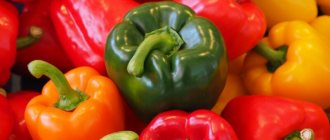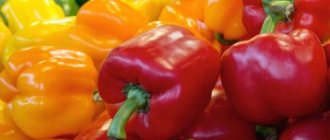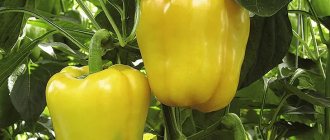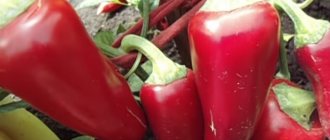Vegetable growing » Pepper
0
1205
Article rating
Kira Stoletova
Green pepper is a type of bell pepper that is specially harvested before it turns orange, yellow or red. The vegetable came to Europe quite by accident; America is considered its homeland. Today we will find out what the peculiarity of the variety is: its composition, beneficial and harmful properties.
Green pepper
Nutritional value of pepper
Green bell peppers often become the main ingredient in weight loss diets. The fact is that the vegetable is low in calories, which allows you to eat it in large quantities without fear of gaining weight. 100 grams of pepper contains about 40 calories.
It is thanks to the low calorie content of sweet green peppers that you can get your weight in order and lose several kilos in a fairly short period of time. Isn’t this a miracle?
Indicators of fetal BJU (per 100 g):
- Carbohydrates – 7 g
- Proteins – 1.5 g
- Fats –0.2 g
Application
green pepper is added to salads, meat and vegetable dishes; it will add a specific fresh taste to any dish, be it stew, lecho, some kind of sauce, pasta or stew.
Dishes
The hard crunchy structure, delicate sweet aroma and very low calorie content of bell pepper make it universal and one of the most popular products in cooking, including dietary and health nutrition. The fruits are eaten raw, added to salads, soups, stews, stuffed, baked, fried, seasoned, baked and canned.
The sweet, aromatic vegetable is included in many diets. Scientific research has proven that the smell of pepper dulls the feeling of hunger, dietary fiber provides long-term satiety, and vitamins, minerals and other beneficial elements accelerate metabolism and support the body during periods of limited nutrition.
Stuffed
The main thing in this recipe is preparing the filling. To do this, fry 2 onions, cut into small cubes, and 3 grated carrots in a small amount of vegetable oil. Grind 3 tomatoes in a blender, after dousing them with boiling water and peeling them. Mix the tomato mass with ½ part of the carrot-onion fry, add a little water and mix.
Boil ½ cup of long grain rice until half cooked. Cool slightly, combine with 600 g of minced meat and the remaining half of the fried onions and carrots, salt and pepper to taste. Mix everything well. This filling is enough to fill 7-9 sweet bell peppers, depending on size.
The calorie content of bell peppers stuffed with meat and rice is 126.4 kcal/100 g. If desired, the recipe can be made vegetarian by excluding minced meat. At the same time, the calorie content of the dish will be reduced by almost half - to 68 kcal/100 g.
Stewed with tomatoes
Core 8 sweet bell peppers, cut into small slices, fry in 2 tbsp. l. vegetable oil. Separately, cut 4 tomatoes into small cubes, chop 3 cloves of garlic, mix all the ingredients. Salt, add 1 tsp. sugar and simmer for 30 minutes at a low boil.
It turns out to be a very simple, but very interesting snack, with a total calorie content of 67 kcal/100 g. It can be consumed as a separate dish or as an addition to a side dish.
During frying, it is not recommended to let sweet bell peppers change color. As soon as the characteristic “fried” aroma appears, you need to add the remaining ingredients. You are allowed to change the proportions of the recipe components at your discretion. If you add tomatoes, the dish will turn out more liquid, like a gravy, and is better suited for eating with a side dish. When preparing your own snack, it is better to reduce the number of tomatoes.
Grind (finely chop or mince) 3 kg of tomatoes. The resulting tomato mass is boiled for 15 minutes. Then add 100 ml of sunflower oil, 100 g of sugar, salt to taste and 1.5 kg of sweet peppers cut into 4 pieces. After boiling, cook for exactly 25 minutes. Add 100 g of chopped garlic and 50 ml of vinegar to the lecho, boil for another 5 minutes.
The calorie content of lecho made from bell pepper and tomato is 50.2 kcal/100 g. The finished dish can be consumed immediately after cooling or, if desired, still hot, placed in sterilized jars and stored for the winter.
Grilled salad
Cut 2 peppers (preferably different colors), 1 medium-sized tomato and 4 olives in random order. Place on the grill and simmer for 15 minutes. Place the prepared vegetables in a deep plate and season with 1 tbsp. l. balsamic vinegar and mix gently.
A colorful mix of grilled vegetables is used as a side dish for meat and as an addition to boiled potatoes, rice or pasta. The calorie content of bell peppers with such additives is 107 kcal/100 g. If you add pieces of goat cheese to this dish, you get a traditional Mediterranean salad.
Soup puree
Pour 1 tbsp into a thick-bottomed pan. l. olive oil, add finely chopped 4 shallots and 1 tsp. salt. Simmer until the onion becomes soft. Add 0.5 liters of low-fat chicken broth and 1 head of cauliflower, disassembled into inflorescences. Bring to a boil, cook for 20 minutes over low heat. At this time, bake in the oven or lightly stew until soft 6 red Bulgarian “berries” without the core to remove the skin. Allow the broth and pulp to cool, then pour everything into a blender and grind until smooth.
The calorie content of this soup is 191 kcal/100 g. The result is a light, healthy and satisfying dish that can be included in the diet of any diet. Vegetarians can replace chicken broth with vegetable broth.
Composition of pepper
Vitamins
Everyone knows about the benefits of vegetables, as they contain a lot of vitamins.
green pepper is the record holder among vegetables for vitamin C content; it is surpassed only by red currants and rose hips. It is necessary to say about vitamin P, which is also present in its composition. The maximum concentration of this vitamin is found closer to the stalk, so you should not remove it completely.
This composition has a beneficial effect on the condition of the heart, benefiting the entire circulatory system. Regular consumption of pepper will make blood vessels more elastic, clearing them of plaque.
Doctors say adding yellow or green bell peppers to your diet can help reduce your risk of stroke by 48%.
The vegetable is also rich in vitamin A; in this indicator it even surpasses carrots. If you want to have beautiful skin, prevent the formation of early wrinkles, and not lose vision with age, you should definitely include pepper in your diet.
The vegetable also contains B vitamins, which have a beneficial effect on the nervous system, improve mood, and normalize sleep.
Microelements
- Potassium is vital for the normal functioning of the heart muscle.
- Iron has a beneficial effect on blood circulation.
- Silicon is responsible for the beauty of skin and hair.
- Iodine has a positive effect on mental activity.
Capsoicin in green pepper
It is worth saying that green pepper is a direct relative of capsicum black pepper, as well as a variety such as chili pepper. All three varieties contain a unique component called capsoicin, which gives the fruit its characteristic taste. You can be sure that you will not spoil the taste of the dish with pepper, because capsoicin is found in large quantities only in the seeds.
The pepper itself also contains this beneficial substance, which has a beneficial effect on appetite, improving the entire digestion process. For this reason, the green vegetable is often used in appetizers to whet the appetite before the main course.
Useful product
Pepper - proper planting and seed preparation
It should be noted that the seeds of bell pepper varieties have maximum germination only during the first year after they are collected, then the percentage of germination rapidly decreases. The crop is sown for seedlings at the end of February or early March.
To check the quality of the seeds and select the most viable ones, you need to put all the available seed into a container filled with a saline solution - 1.5 teaspoons of table salt per glass of water at room temperature. Weak seeds that float to the surface can be thrown away without regret, and those that sink to the bottom can be taken out, rinsed with water, dried on a paper towel and prepared for sowing.
Before placing seeds in the ground, it is necessary to carry out a number of preparatory work:
- Disinfect the seeds in a 1% solution of potassium permanganate for half an hour, then rinse thoroughly with clean water.
- It is advisable to soak the seed in a solution of ash or any other stimulant for a day, then rinse it in water and leave it on a saucer for pecking under damp gauze and regularly spray it with a spray bottle.
- The swollen seeds are deepened 1 centimeter into containers with pre-moistened soil, which are covered with glass or film, and placed in a warm place near the radiator.
The optimal germination temperature is +25 degrees.
Principles of growing seedlings
Immediately after the first shoots appear in the containers, they must be moved to sunlight and the glass or polyethylene that previously covered the plantings must be removed. Caring for seedlings involves:
- Regular spraying of the soil with a spray bottle or careful watering.
- Application of liquid fertilizers on days 13–15 from the appearance of sprouts.
- Picking plants into separate cups immediately after the formation of the first pair of leaves.
Sweet peppers will be completely ready for planting in open ground or a bed in a greenhouse after 2 months of growing in a pot. At that time, the plants should have 15–18 true full-fledged leaves.
Planting seedlings in greenhouse conditions - timing and scheme
In central Russia, pepper seedlings are usually planted in unheated polycarbonate greenhouses in the second half of May, having previously prepared the soil and organized a system of additional shelter in case of low night temperatures.
A structure made of metal arcs covered with a thick polyethylene film or special non-woven material can act as a shelter. During the day, the insulation is carefully rolled up so that the plants are provided with oxygen and sunlight, and at night it is again lowered onto the installed arcs. Additional insulation can be completely removed after June 10, when the threat of return frosts in the middle zone has finally passed.
By that time, the soil in the greenhouse or greenhouse should warm up to +18 degrees. When preparing the soil, 1.5 buckets of compost, 35 grams of potassium chloride, 40 grams of ammonium nitrate and 55–65 grams of superphosphate are added per 1 meter of area, after which the soil is thoroughly dug up and allowed to sit for at least 1 week before planting.
The pepper planting pattern depends on the height of the bushes of the selected variety. Tall plants are planted 5 pieces per 1 square meter with an interval of 40 centimeters and a distance between rows of 70 centimeters. Low-growing varieties are planted a little denser, with 6–7 roots per square meter.
Only the root system of the plant is buried in the holes; the growth point should remain at the level of the ground surface.
Planting peppers in open ground
Pepper seedlings can begin to be planted in open-air beds by the end of May in the middle zone and in early May in the southern regions of Russia. It is advisable to plant in the evening so that the cool night weather can help the young bushes get stronger and get used to the new growing place. In cloudy weather, seedlings can be planted at any time of the day.
The seedlings are moved into the holes along with a small ball of earth, since the vegetable tolerates damage to the root shoots extremely negatively and often dies without ever recovering from the transplant.
Beneficial features
Green pepper can be useful in the following cases:
- Regular consumption of this type of pepper will be useful for hair loss, this is especially true for alopecia in men;
- Due to the fact that green bell pepper does not contain starch, it is recommended to be eaten by people with diabetes, the same applies to red pepper;
- It is recommended to include in the menu for pregnant women, as well as couples at the stage of planning a child. The fact is that the composition of the vegetable can compensate for the deficiency of microelements such as iron, calcium and potassium, which the expectant mother so needs;
- Pepper contains beta-carotene, which has an extremely positive effect on visual acuity.
- Improves digestion
- It is worth including pepper in the menu if you have problems with blood pressure, namely, you suffer from hypertension
- Improves the immune system. With its help you can get rid of diseases of the upper and lower respiratory tract and even get rid of asthma attacks
- It can also be used externally, for example, making lotions and ointments based on it to treat neuralgia and radiculitis
- If you are engaged in mental work, you should eat green bell pepper, it can help improve memory and increase attention
- Red and green peppers are often a component of cosmetic products because they have skin whitening properties and also strengthen hair. Some people use self-prepared masks to get rid of freckles and simply improve the condition of their skin.
Cancer Prevention
Scientists from Italy came to the conclusion that bell peppers contain substances in their chemical composition that prevent the formation of cancer. Most effective in the fight against breast cancer.
Of course, to cure cancer that has already developed, but having it in the diet will be a good prevention. It is enough to eat just 1 pepper a day, this will be enough to protect yourself from this insidious disease.
What are the benefits of bell pepper?
Sweet peppers belong to Capsicum annuu, an annual herbaceous plant from the genus Capsicum of the Solanaceae family. The vegetable received this name in Latin for its appearance (capsa in Latin means bag) and the characteristics of the growing period (annuum - annual). America is considered the birthplace of bell peppers, from where the plant later came to European territory. However, in Russia they are accustomed to calling the plant Bulgarian, and in Bulgaria – sweet.
Sweet peppers contain microelements such as potassium, magnesium, sodium, iodine, iron, zinc, calcium, and phosphorus. It contains vitamins B, A, E, K, P, C, fiber, phytosterols. The product has a characteristic taste thanks to the alkaloid capsaicin, present in all varieties of capsicum - a substance that has a detrimental effect on malignant cells. The bright color (yellow, green, red) is due to lycopene, another antioxidant found in the vegetable.
Valuable substances are concentrated around the stalk inside in the white pulp and seeds (see photo). When cooked, they lose their quality, so it is recommended to eat fresh vegetables separately or add them to vegetable salads. The beneficial properties of bell pepper are extensive and demonstrate their positive impact on health in many areas:
- increasing immunity, protecting against colds;
- reducing the likelihood of cancer;
- thinning and improving blood composition, strengthening the walls of blood vessels, preventing anemia;
- normalization of the gastrointestinal tract, increased appetite;
- improved vision;
- decreased blood pressure;
- beneficial effect on the nervous system, reduction of depression;
- improved memory, which is especially valuable for older people;
- reducing cravings for smoking;
- improving the condition of skin, hair, bones, nails.
For women
This beloved sweet pepper is beneficial for men and women. Lastly, the beneficial substances of the vegetable help maintain a youthful appearance, and for pregnant women, the use of the plant is especially important: during this period, during special stress on the woman’s skeletal system, the product must be included in the daily diet to strengthen hair, nails and teeth.
The benefits of sweet pepper for preserving youth are actively used in cosmetology: it is added to anti-aging masks to saturate the skin with vitamins. The plant increases appetite, but due to its low calorie content (25 kcal/100 g), it is useful for those who want to lose weight, and eating pepper, which contains the joy hormone, unlike chocolate, does not threaten weight gain.
Harm of green pepper
Not recommended for a sick stomach
Even such a healthy product as sweet green peppers has a list of contraindications that should be a reason to avoid consuming it. These include:
- Hypotension
- Gastritis
- Stomach ulcer
- Haemorrhoids
- Liver diseases
- Kidney diseases
Contraindications
Green bell peppers are not advisable for people suffering from:
- angina pectoris;
- tachycardia;
- hypertension;
- gastritis;
- increased acidity of gastric juice;
- stomach and duodenal ulcers;
- colitis;
- renal failure;
- liver pathologies;
- insomnia;
- epilepsy;
- hemorrhoids.
Some people, when overeating, develop an allergic reaction, nausea, vomiting, diarrhea, and stomach pain.
How to preserve vitamins
We all know how difficult it is to retain all the vitamins and microelements in fruits and vegetables. Green peppers have a shelf life of about 7 days in the refrigerator. To increase its lifespan, you can pickle the pepper. In this case, it is possible to preserve about 70% of all vitamins and microelements. However, people with heart disease need to be careful here, as the marinade and pickles contain a high salt content, which can cause an increase in blood pressure.
You can also freeze the vegetable, with this method it is possible to preserve about 100% of the nutrients. To do this, you need to wash the vegetable and remove the seeds and tail.
It is forbidden to refreeze peppers so as not to destroy the remaining vitamins. For convenience, you can portion the peppers into small bags to defrost the required amount.
Methods for storing green peppers
Fresh vegetables can be stored in the refrigerator for no more than 1 week. If long-term storage is required, the peppers are pickled or frozen.
Freezing
Pre-frozen peppers are later used to prepare various recipes - soups, stews, various salads. Procurement rules:
- the pepper is thoroughly washed and finely chopped;
- if the workpiece will be used for stuffing, the pods cannot be cut off; it is enough to remove the seeds and freeze them whole.
Attention! Pepper defrosts naturally, without using water. Vegetables cannot be re-frozen.
You can freeze the vegetable whole or in chopped form.
Pickling
When pickled, the vegetable retains most of its beneficial properties. There are many ways to prepare it - lecho, fried pods, assorted vegetables, and they all turn out simply excellent - you'll lick your fingers.
When pickling, only containers are subjected to sterilization. Pepper cannot be subjected to prolonged heat treatment, because... This gives the vegetable pulp a bitter taste.
How to choose pepper
If you buy green peppers, you need to pay attention to how they look. The fruit should be dense and elastic, its skin should be smooth and not have any damage. Pay attention to the tail, it must be green and not dry.
Remember that fruit maturity can be determined not only by size, but also by color. The darker the color of the vegetable, the more mature it is; moreover, as the vegetable ripens, it turns a little red.
Ripeness directly affects the taste - an unripe vegetable will taste more bitter and may be a little tart. If you bought an unripe vegetable, place it on the windowsill to ripen; in 2-3 days the fruit will ripen.
Now you know what the benefits and harms of green sweet pepper are, we have analyzed its chemical composition in detail and provided a list of vitamins it contains, be sure to include it in your menu and be healthy.
The health benefits and harms of bell peppers. Benefits for men and women
The popularity of bell pepper in Europe and Russia is quite high, despite the fact that its homeland is America. I fell in love with it due to its fresh, juicy taste and crispy flesh. The vegetable is used to prepare many dishes: salads, appetizers, winter preparations, etc.
In its homeland, pepper grows like a weed that does not require any care. In the 20th century, Bulgarian breeders (apparently, this is where the name of the product came from) identified several of its species, which we can now see on store shelves. They differ in color and shape.











